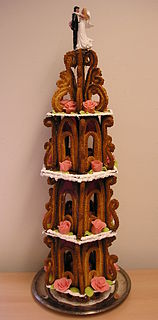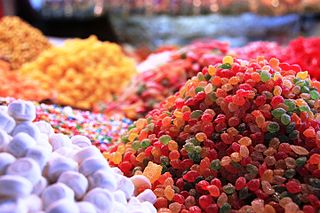
Confectionery is the art of making confections, which are food items that are rich in sugar and carbohydrates. Exact definitions are difficult. In general, however, confectionery is divided into two broad and somewhat overlapping categories: bakers' confections and sugar confections. The occupation of confectioner encompasses the categories of cooking performed by both the French patissier and the confiseur.

Candy, also called sweets or lollies, is a confection that features sugar as a principal ingredient. The category, called sugar confectionery, encompasses any sweet confection, including chocolate, chewing gum, and sugar candy. Vegetables, fruit, or nuts which have been glazed and coated with sugar are said to be candied.

A chocolate bar or candy bar is a confection containing chocolate, which may also contain layerings or mixtures that include nuts, fruit, caramel, nougat, and wafers. A flat, easily breakable, chocolate bar is also called a tablet. A wide variety of chocolate bar brands are sold. A popular example is a Snickers bar, which consists of nougat mixed with caramel and peanuts, covered in milk chocolate.

Fudge is a type of sugar candy that is made by mixing sugar, butter and milk, heating it to the soft-ball stage at 240 °F (115 °C), and then beating the mixture while it cools so that it acquires a smooth, creamy consistency. In texture, this crystalline candy falls in between fondant icing and hard caramels.

York Peppermint Pattie is an American dark chocolate enrobed peppermint confection introduced in 1940 and currently produced by the Hershey Company.

Baby Ruth is an American candy bar made of peanuts, caramel, and milk chocolate-flavored nougat, covered in compound chocolate. It is distributed by the Ferrara Candy Company, a subsidiary of Ferrero.
Brach's is a candy and sweets brand of Ferrara Candy Company.

Oh Henry! is a candy bar containing peanuts, caramel, and fudge coated in chocolate.

Mounds is a candy bar made by The Hershey Company, consisting of shredded, sweetened coconut coated in dark chocolate. The company also produces the Almond Joy, a similar bar topped by whole almonds and covered in milk chocolate. The two products share common packaging and logo design, with Mounds using a red color scheme and Almond Joy blue.

Russell Stover Chocolates, Inc., founded by Russell Stover, an American chemist and entrepreneur, and his wife Clara Stover in 1923, is an American supplier of candy, chocolate, and confections. The corporate headquarters are in Kansas City, Missouri.

PayDay is a brand of a candy bar first introduced in 1932 by the Hollywood Candy Company. The original PayDay candy bar consists of salted peanuts rolled over a nougat-like sweet caramel center. Since 1996, classic PayDay candy bars without chocolate have been continually produced by The Hershey Company. In 2020, Hershey's released a "Chocolatey PayDay bar" as a permanent part of the PayDay product line; it is identical to the regular bar, but covered by a layer of chocolate.

Liberty Orchards is a packaged food products company located in Cashmere, Washington. Founded as an apple farm in 1918 by Armenian business partners Armen Tertsagian and Mark Balaban, the company moved into canning and then confectionery during the 1930s and 1940s.

Pearson's Candy Company is an American chocolate and confectionery manufacturer headquartered in Saint Paul, Minnesota. Founded as a confectionery distribution firm in 1909, the company began to manufacture its own products in 1912. Originally a family-owned company, Pearson's experienced changes in ownership, acquisitions and product alterations in the 1960s, 1970s and 1980s, before its most recent sale in November 2018 to Spell Capital, a Minneapolis private equity firm.

Russell William Stover was an American chemist and entrepreneur, and co-founder, with his wife Clara, of Russell Stover Candies.
The following outline is provided as an overview of and topical guide to chocolate:

Crunch is a chocolate bar made of milk chocolate and crisped rice. It is produced globally by Nestlé with the exception of the United States, where it is produced under license by the Ferrara Candy Company, a subsidiary of Ferrero.

A candy bar is a type of candy that is in the shape of a bar. The most common type of candy bar is the chocolate bar, including both bars made of solid chocolate and combination candy bars, which are candy bars that combine chocolate with other ingredients, such as nuts, caramel, nougat, or wafers.




















